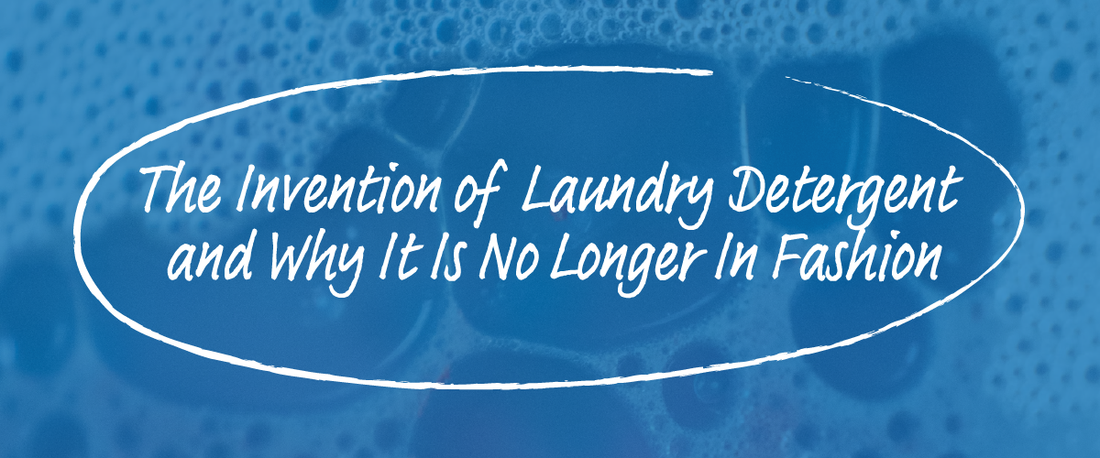Before the arrival of modern detergents, ancient civilizations utilized animal fat or lye for washing clothes. In certain instances, they also made use of chamber lye, a more informal term referring to urine. It wasn’t until 1914 in Germany that Otto Rohm created the concept of adding enzymes to washing detergents. [1] From that fateful day on, laundry would never be the same.
The Rise of Laundry Detergent
Proctor & Gamble invented laundry detergent as we would recognize it today in the 1930s. After World War II synthetic detergents were the norm. They were easy to use and big companies like Tide and Persil were in every store. Jennifer L. Betts [2] created a comprehensive timeline of laundry detergent’s rise to fame:
- 1950s - Liquid and powder laundry detergents become popular purchases along with bleaches for whiter whites and fabric softeners to soften clothes.
- 1960s - Stain removers and pre-treatments are added to the shelves. Enzymatic laundry detergents are introduced. Homes also used laundry tablets.
- 1970s - Fabric conditioners included in laundry detergent for an all-in-one product.
- 1980s - Varying temperature laundry detergents and concentrated laundry detergents grow in popularity.
- 1990s - Biodegradable cleaners, conditioners, and color-safe bleach are big sale items on the laundry detergent aisle.
- 2000s - Biodegradable and green-friendly products and water conservation are big-ticket issues for modern concepts of laundry detergent.
- 2010s+ - Laundry pods and sheets available in dissolvable units that provide a quick, single-serving of laundry detergent to prevent waste and overuse of detergent. Introduction of detergents specifically for synthetic fibers.
From its first incarnation detergent annihilated stains, killed bacteria, and wreaked havoc on the environment. Phosphates, which were once commonly used in detergents, can cause algal blooms in water bodies, leading to oxygen depletion and harm to aquatic ecosystems. Today microplastics found in laundry detergents find their way into our drinking water. It’s time to take the future in a different direction. That’s where we step in, O3waterworks is the detergent-less, toxic chemical-free clean, that protects our waterways without compromising on vivid colors and sparkling whites.
Tide is On Its Way Out
On January 1st 2022 New York State joined Europe in banning all but trace amounts of 1, 4 Dioxane [3]. This chemical byproduct is found in the vast majority of laundry detergents on the market, including Tide, “America’s Favorite Detergent”. This common solvent can be dangerous to those exposed and may cause lung and kidney damage. At O3waterworks we guarantee a non-toxic, toilet humor-free clean for today’s consumer.
How O3 Solves The Solvent Problem
We’ll tell it to you straight, our solution is…water. Ozonated water that is. For centuries O3, a powerful oxidizing solution, has been used to treat water supplies and kill bacteria since 1904. This extreme clean is perfect for detergentless laundry that keeps you smelling fresh and looking fresh every time you press the button. In fact, O3 is the same reaction created by waterfalls, ocean waves and during thunder and lightning storms.The Smart Laundry System Plus easily connects to your standard washing machine and kills 99.9%* of bacteria every time. Detergent is now a thing of the past.
*All of our efficacy claims are independently tested by 3rd party laboratories and Aqueous Ozone is GRAS (Generally Regarded as Safe) by the FDA.
Sources:
[1] Wipeout Team. 2018. “Laundry detergent, All You Need To Know.” Wipeout. https://www.wipeout.ie/blog/laundry-detergent-history.html.
[2] Betts, Jennifer L. n.d. “Laundry Detergent History: Changes Through the Years.” LoveToKnow. Accessed February 20, 2024. https://www.lovetoknow.com/home/cleaning/laundry-detergent-history.
[3] Ithos Global Regulatory Team. 1, 4 Dioxane Now Banned in New York State. Ithos. January 12, 2022.


